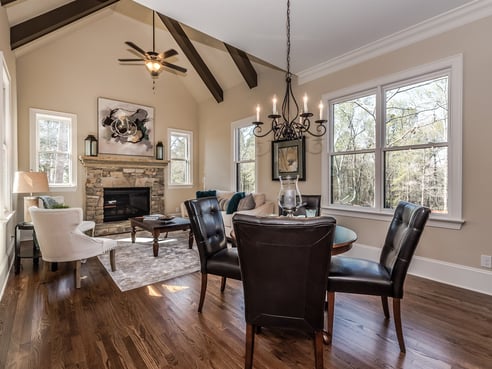
“Flow” is a term used a lot when it comes to good interior design. We hear it a lot in the staging community and it’s something seasoned sellers – particularly agents and developers – know to look for when building and staging a property. But what is it, and why does it matter when it comes to staging a property?
There are two ways to think about ‘flow’ for staging.
The Flow of People Through a Space
Arguably the more important side of a space that ‘flows’ is how people move about a room. Traffic flow is crucial when it comes to the layout of a space, and it’s not all about furniture; the way a builder actually configures a room’s walls, windows, and focal points such as fireplaces can actually impact the human flow.
When it comes to good staging practices, it’s important to visualize how people will move about and use a space to decide how to the design should “guide” them through it. In general, people need about 18” of space to comfortably move around furniture without feeling squished. That means selecting an appropriately-sized coffee table for the sofa might make the difference in whether or not a buyer feels cramped in the space. If a piece of furniture forces the body to move one way or another to avoid it, it’s not helping the flow of a room!
Flow is also important for spaces that aren’t well defined. Today’s home design is trending toward open layouts, but it can be hard to get the flow correct in these massive rooms. Experienced stagers can help set up vignettes of space – mini-rooms! – designed to help people flow through them, utilize them, then flow back into the larger space without hurdles.
The Flow of Design Throughout a House
Nearly as important as the flow of movement is the flow of design. Have you ever been in a home that has a decidedly modern kitchen – all polished chrome and subway tiles – and then walk into a guest room that’s bedecked in chunky, traditional cherry wood furniture? It’s jarring, and it gives a sense of haphazardness to a space. Thoughtfully flowing design shows buyers you’ve thought about the overall flow of the home, not just specific rooms.
A few design elements that really impact the visual flow of a home are paint colors and overall color schemes, furniture styles, and flooring. When in doubt, using the same flooring throughout a level of the home is always safe. As for paint colors, sticking with various shades of the same color is also a good way to encourage good flow. Furniture can be trickier, but that’s where the expertise of a stager comes in.
Staging a home is all about making it feel livable and inviting. Flow is an important piece of that puzzle. Creative Home Stagers knows how to make your newest project flow.
Call us today to find out more.
